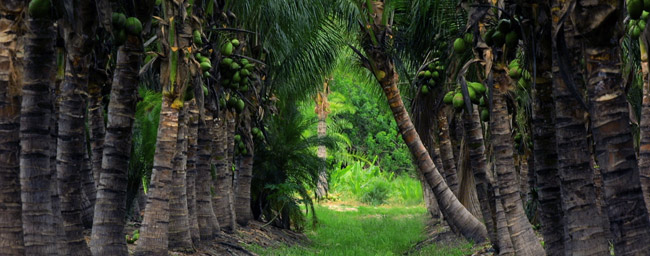Palm Trees For Sale

Palmco is located in the sleepy community of Bokeelia on Pine Island, Florida, where we have over 600 acres of palm trees and clumping bamboo for sale.
As you look at our incomparable selection, we encourage you to talk to our professionals about our state-of-the-art facilities and environmentally conscious growing process before you decide on the most suitable tree(s) for your project.
Palms love our Florida climate and make an impressive statement in commercial and residential landscapes throughout the state.
Small varieties with visible, attractive trunks and fluffy, full-to-the-ground palms are spectacular as backdrops or when surrounded by small or mid-size flowering shrubs. Large varieties, whether broad and majestic or slim and willowy, make striking silhouettes in any environment.
Palm Trees In USDA Zones 8B and 9
North and Central Florida enjoy moderate temperatures year round due to the region’s humid subtropical climate. The coolest part of the region includes Tallahassee and most of the Panhandle, where low winter temperatures range between 10°F and 20°F, placing this part of the state in Zone 8B.
Examples of palms that will flourish in Zone 8B are: European Fan, Mule, Nitida, Pindo, Sabal Palmetto, Sylvestris, Washingtonia, and Windmill.
Pensacola, Panama City, Jacksonville, Gainesville and Ocala fall into?Zone 9A, with lows ranging from 20°F to 30°F.
And then the eastern coastal cities of Daytona Beach, Titusville, and Melbourne, the interior around Orlando, Kissimmee, Sanford and Lakeland, and the Gulf Coast cities of Clearwater, Largo, St. Petersburg and Tampa fall into Zone 9B, where hard freezes (below 28?°F) are rare.
Palms that thrive in Zones 9A and 9B include those listed for Zone 8B above as well as: Canary, Carnaday, Chinese Fan, Lady, Reclinata, and Ribbon. The Paurotis Palm (also known as the Everglades Palm) is native to South Florida and may not tolerate temperatures below 25°F below Zone 9B.
Palm Trees In USDA Zones 10 And 11
South Florida can be divided into 3 zones – 10A, 10B and 11 – based on the average high and low temperatures in the different regions.
Zone 10A encompasses most of the southeastern part of the state that borders the Atlantic Ocean, stretching southward from Vero Beach and Port St. Lucie into the Florida Keys.
It also includes southwest Florida, home to Palmco, which stretches along the Gulf of Mexico from the southern part of Sarasota County, through Port Charlotte and Punta Gorda, continuing southward through Cape Coral, Fort Myers, Bonita Springs, Naples and Marco Island.
Palms That flourish In Zone 10A
Areca, Canary, Caranday, Chinese Fan, European Fan, Fishtail, Lady, Mule, Nitida, Paurotis, Pindo, Queen, Reclinata, Roebelenii, Royal, Sabal Palmetto, Silver Bismarckia, Sylvestris, Washingtonia, and Windmill.
Zone 10B encompasses the southern section of southeast Florida, which includes most of Palm Beach County and all of Broward and Miami-Dade counties. Monroe County, Florida’s southernmost county, covers the Florida Keys and falls into USDA Zone 11.
In Zones 10B and 11, look for the palms listed for Zone 10A plus: Adonidia, Alexander, Bottle, Dwarf Sugar, Foxtail, Green Malayan Coconut, King Alexander, Maypan Coconut, Montgomery, Thatch, and Triangle. Depending on your microclimate, the Mule, Pindo and Windmill palms may not do as well in Zone 11.
Find a vast selection of palm trees for sale from Florida’s premier grower and wholesaler of top quality palms and turn your customer’s outdoor space into a tropical oasis.
Get in touch with Palmco at (239) 283-1329 or (855) GOPALMCO to discuss your custom design requirements.

